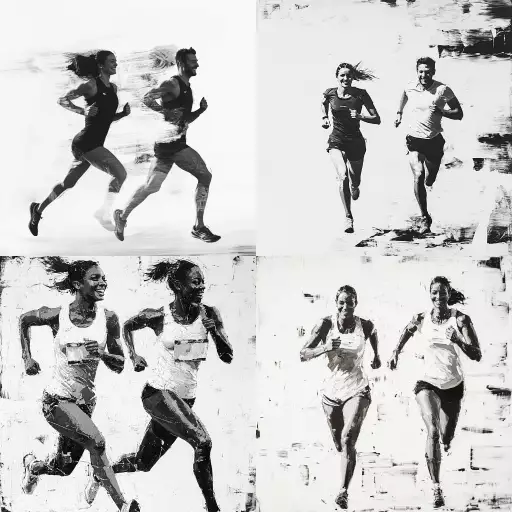Explore the Best AI Image Gallery

Beyond the Canvas: Wearable Tech and the Evolution of Creative Expression
The lines between the physical and digital realms are blurring at an unprecedented pace, driven by advancements in wearable technology. This innovative field is not only reshaping how we interact with the world but also profoundly impacting the creative industries. From artists who harness augmented reality to designers incorporating biofeedback into their work, wearable tech is pushing the boundaries of artistic expression and redefining what it means to create.
A Canvas on Your Body: Exploring Applications in Art and Design
Wearable technology offers artists a multitude of tools to translate their visions into tangible experiences. Imagine a painter using haptic gloves to sculpt digital landscapes or a musician controlling sound waves with gesture-based movements through a smart suit. These are just glimpses into the possibilities offered by wearable interfaces:
- Augmented Reality (AR) Art: AR glasses can overlay digital elements onto the physical world, creating immersive artworks that respond to viewers movements and surroundings.
- Interactive Installations: Wearable sensors can capture data from participants bodies, transforming their actions into dynamic visual displays or altering the course of an installation in real time.
- Biofeedback Integration: Artists can incorporate biofeedback sensors into wearable devices to translate physiological responses like heart rate and brainwaves into artistic expressions, exploring the intersection of technology and human emotion.
- Gesture-Based Design: Wearable controllers allow designers to sculpt, draw, or manipulate digital objects with intuitive hand movements, fostering a more natural and expressive design process.
Beyond Aesthetics: The Impact on Creative Industries
The influence of wearable tech extends far beyond the realm of fine art. It is revolutionizing various creative industries:
- Fashion Design: Smart textiles embedded with sensors and LEDs can create interactive garments that respond to environmental stimuli or user input, blurring the lines between clothing and technology.
- Music Production: Wearable instruments, controllers, and haptic feedback devices empower musicians to explore new sonic landscapes and push the boundaries of musical performance.
- Filmmaking and VR Experiences: Immersive storytelling through VR headsets and wearable motion capture suits allows audiences to step into virtual worlds and engage with narratives in unprecedented ways.
- Gaming and Entertainment: Wearable sensors enhance gaming experiences by allowing for more realistic interactions, personalized avatars, and immersive environments.
Navigating the Ethical Landscape
As wearable tech permeates creative industries, it is crucial to address the ethical considerations that arise:
- Data Privacy and Security: Wearable devices collect vast amounts of personal data. Ensuring responsible data handling practices, user consent, and robust security measures are paramount.
- Bias and Inclusivity: AI algorithms used in creative applications can perpetuate existing biases. It is essential to develop ethical frameworks that promote fairness, diversity, and representation.
- Accessibility and Affordability: Access to wearable technology should not be limited by socioeconomic factors. Efforts should be made to ensure inclusivity and affordability for all creators.
- Intellectual Property Rights: The lines between human creativity and AI-generated content are becoming increasingly blurred. Establishing clear guidelines for intellectual property rights in the context of wearable tech is essential.
Future Trends: A Vision of Creative Possibilities
The future of wearable tech in creative industries holds immense potential:
- Advanced Haptics and Sensory Feedback: Wearable devices will offer more sophisticated haptic feedback, allowing users to experience virtual environments with enhanced realism.
- Brain-Computer Interfaces (BCIs): BCIs could enable artists to control digital creations directly with their thoughts, unlocking a new level of intuitive expression.
- Personalized Creative Experiences: Wearable tech will enable personalized creative experiences tailored to individual preferences and skill levels.
- Collaborative Creation: Wearable devices will facilitate real-time collaboration between artists from different locations, fostering global creative communities.
As wearable technology continues to evolve, it will undoubtedly reshape the creative landscape, empowering artists, designers, and innovators to push the boundaries of imagination and bring their visions to life in unprecedented ways. By embracing these advancements while navigating the ethical considerations thoughtfully, we can unlock a future where creativity knows no bounds.





](https://images.ai-img.art/thumbnails/150/f9584153b4cddd8c9fab611dc10247549b275c59bc173251e37d0935874f9deb.webp)


](https://images.ai-img.art/thumbnails/150/4289d1230b86a96c4d556636c3167bed0ef38f850826549517e4e45db4d87bf7.webp)




](https://images.ai-img.art/thumbnails/150/f67d9af3398150f2ab1bcf250717fea134275e2ca896252b54a4d9bb3719f9ac.webp)


](https://images.ai-img.art/thumbnails/150/bddf3ae4a232290858389b933c866ad3be429ef2e25c23a9f4d7713ed6e44d0b.webp)





](https://images.ai-img.art/thumbnails/150/c2c9c48b38fae37f0a457b80b084ed01ba803810fc8f488c8f610c03abc74049.webp)

](https://images.ai-img.art/thumbnails/150/008b5d5d49667cc2e93a5f8a8adfaa545963da99c39ff0901f5296294636400d.webp)
















